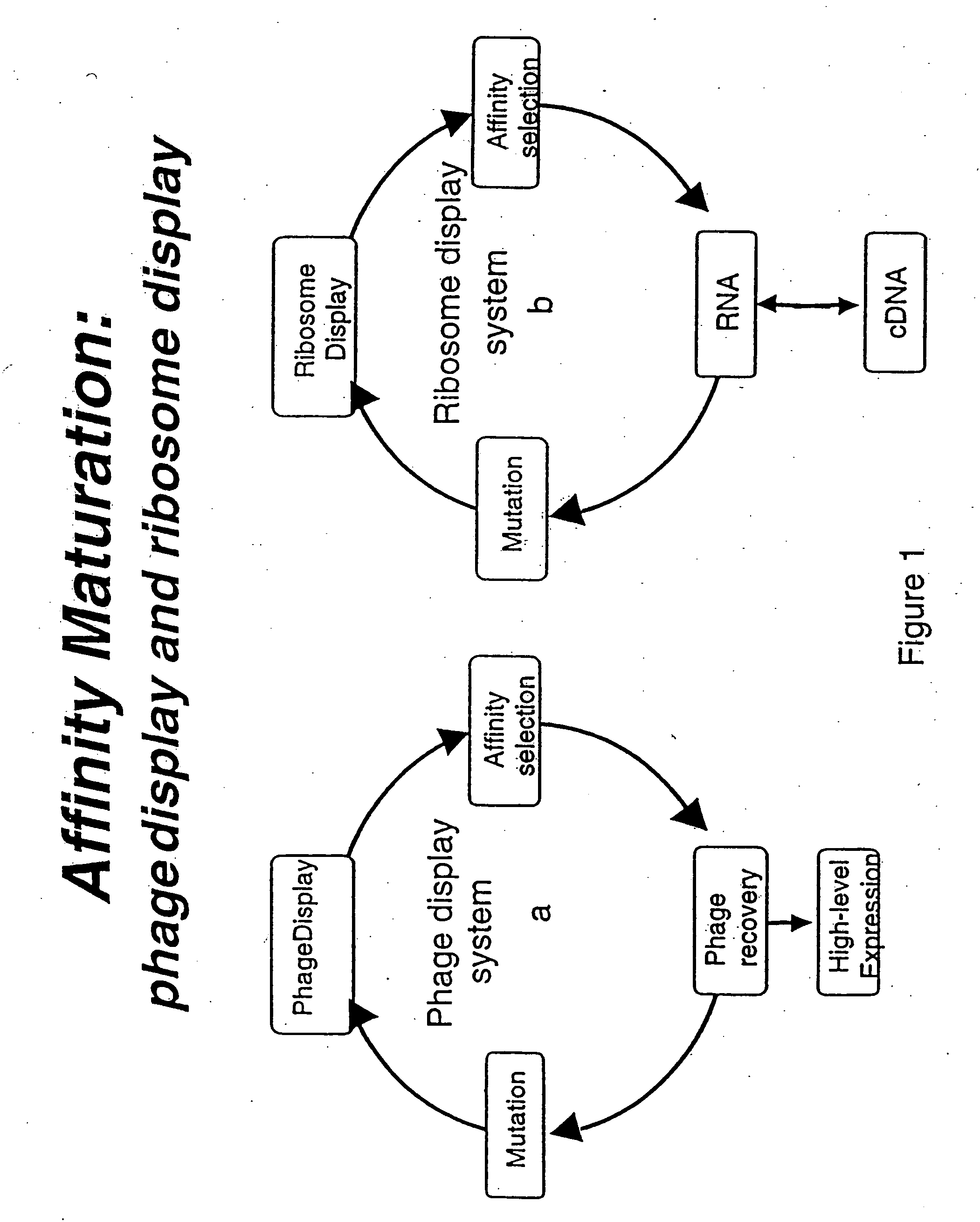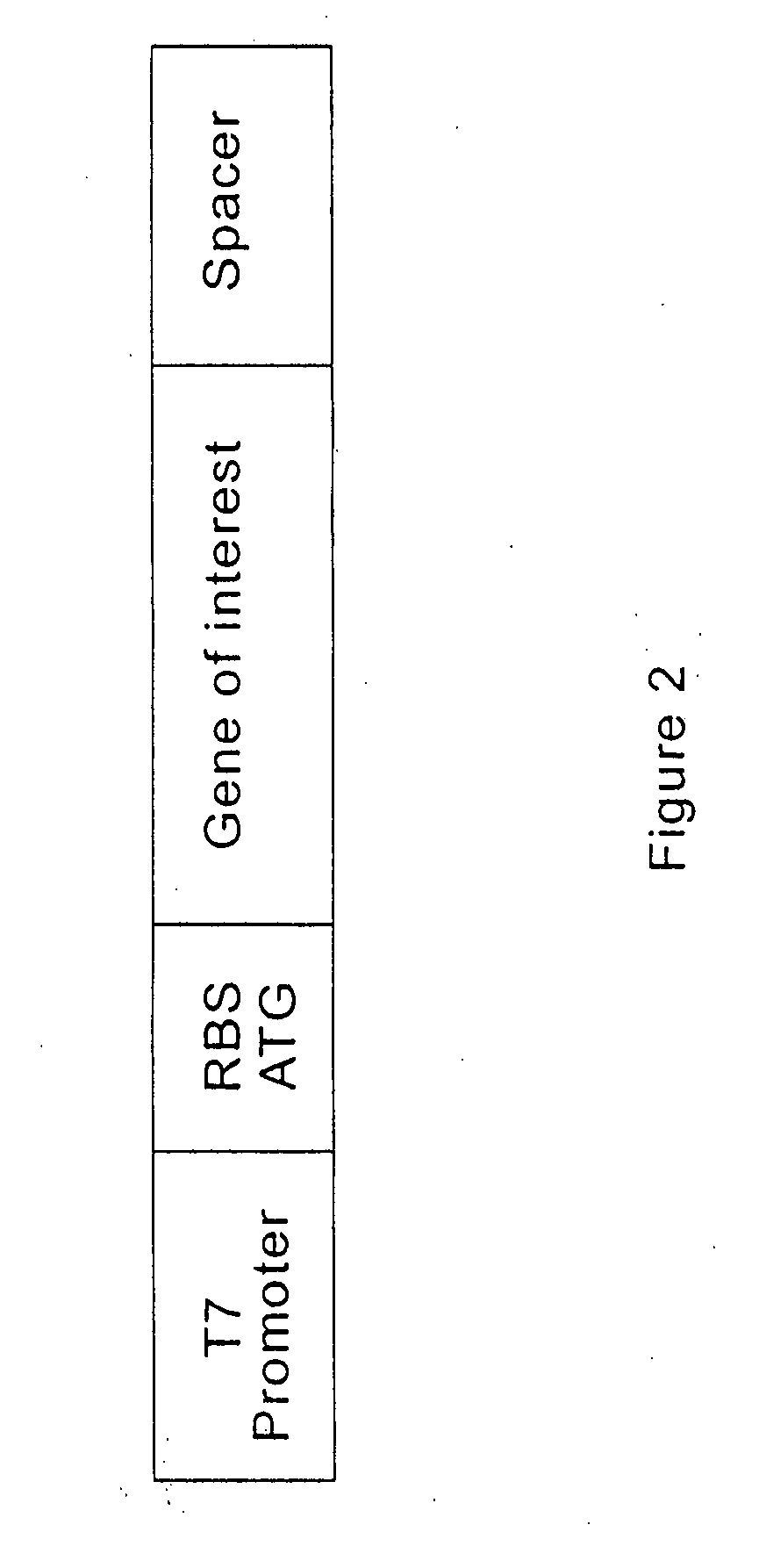Continuous in-vitro evolution
a technology of in vitro evolution and protein mutation, applied in the field of continuous in-vitro evolution, can solve the problems of limited potential of this process, severely limited in vitro strategies, and inability to fully realize the effect of in vitro strategies, and achieve the effect of reducing glutathione, increasing the proportion of correctly folded products, and increasing the amount of recovered products
- Summary
- Abstract
- Description
- Claims
- Application Information
AI Technical Summary
Benefits of technology
Problems solved by technology
Method used
Image
Examples
example 1
Expression and Purification of Recombinant Qβ Replicase
Cloning and Expression
[0125] The Qβ replicase coding sequence was amplified by PCR from the plasmid pBRT7Qβ, a pBR322 based construction (briefly described in Barrera et al., 1993) that was designed to allow the preparation of infectious RNA by transcription using T7 RNA polymerase in vitro, being a cDNA copy of the RNA genome of phage Qβ. The sequence of pBRT7Qβ is shown in FIG. 6. Nucleotide no. 1 is the first nucleotide of the Qβ replicase sense strand. The oligonucleotides used as primers to amplify the Qβ replicase encoded sites for restriction enzyme digestion by the enzymes EcoRI and Not I and the sequences are shown in FIG. 11.
[0126] The PCR products were purified using any one of the commercial products available for this purpose (for example, Bresatec). The purified DNA was cloned into the EcoRI and NotI sites of the vector pGC (FIG. 7a) using standard molecular biology techniques. The vector pGC and expression of ...
example 2
Cloning of Qβ Replicase into the Eukaryotic Expression Vector pCDNA3.1
[0144] Qβ replicase coding sequence was cloned into the eukaryotic expression vector pCDNA 3.1 (FIG. 9) to produce the vector named pCDNAQβ. This vector was used for the expression of Qβ replicase in situ in the coupled transcription / translation system and concomitant replication / mutation of target RNA. Sequence of oligonucleotides used as primers in PCR amplification of Qβ replicase for cloning into the EcoRI and NotI restriction sites in the eukaryotic expression vector pCDNA3.1 were:
(SEQ ID NO:28)#5352 5′TCTGCAGAATTCGCCGCCACCATGTCTAAGACAGCATCTTCG(SEQ ID NO:29)#5350 5′TTTATAATCTGCGGCCGCTTACGCCTCGTGTAGAGACGC
[0145] The coding sequence for the Qβ replicase b subunit was cloned into the pCDNA3.1 by standard molecular biology techniques (Sambrook et al., 1989). The cloned sequence was confirmed by DNA sequence analysis. Expression of the Qβ replicase in the rabbit reticulocyte coupled transcription / translation sys...
example 3
Construction by PCR of DNA Templates for Transcription
[0147] DNA sequences were amplified by standard and well-described techniques (Polymerase Chain Reaction [PCR] with specifically designed oligonucleotide primers, splice overlap extension, restriction enzyme digests, etc.) using either Taq, Tth, Tfl, Pwo or Pfu polymerase, according to the supplier's instructions, and using either an FTS-1 thermal sequencer (Corbett Research), a PE2400 (PerkinElmer) or a Robocylcer® gradient 96 (Stratagene). A list of oligonucleotide primers used is given in FIG. 11. Products were gel purified using BresaClean™ (Bresatec) or used directly in coupled transcription and translation reactions.
[0148] DNA sequences were amplified from starting templates that had been cloned into either vector pGC038CL (FIG. 7a) or vector pGC_CH (FIG. 7b), which provided an extension to the 3′ terminus of the construct. This extension was either a constant region from a mouse monoclonal antibody (1C3; Sequence FIG. 5a...
PUM
| Property | Measurement | Unit |
|---|---|---|
| optical density | aaaaa | aaaaa |
| temperature | aaaaa | aaaaa |
| pH | aaaaa | aaaaa |
Abstract
Description
Claims
Application Information
 Login to View More
Login to View More - R&D
- Intellectual Property
- Life Sciences
- Materials
- Tech Scout
- Unparalleled Data Quality
- Higher Quality Content
- 60% Fewer Hallucinations
Browse by: Latest US Patents, China's latest patents, Technical Efficacy Thesaurus, Application Domain, Technology Topic, Popular Technical Reports.
© 2025 PatSnap. All rights reserved.Legal|Privacy policy|Modern Slavery Act Transparency Statement|Sitemap|About US| Contact US: help@patsnap.com



